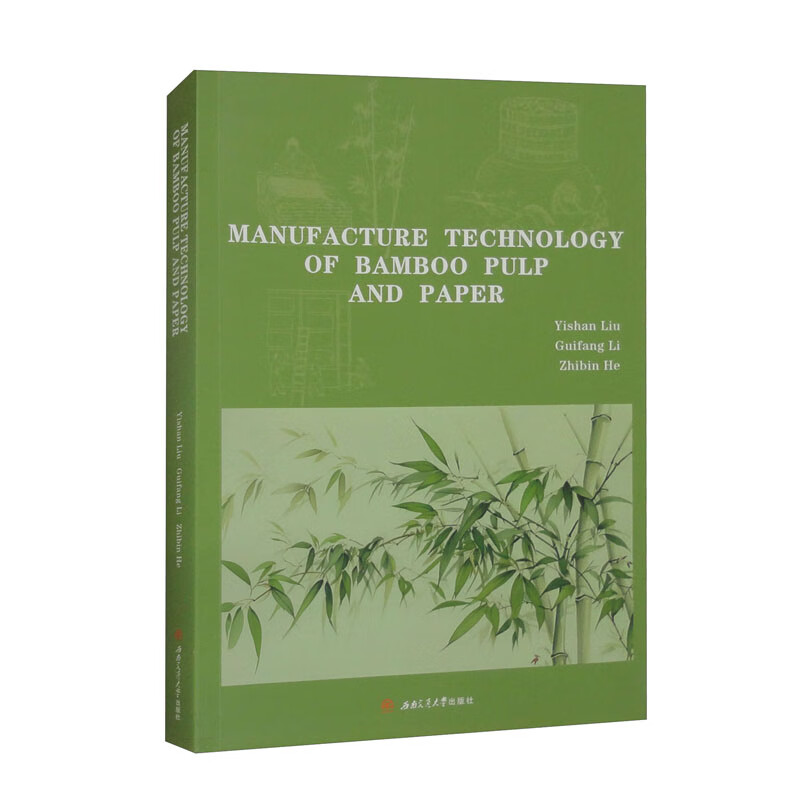
Manufacture technology of bamboo pulp and paper

- ISBN:9787564398149
- 装帧:平装-胶订
- 册数:暂无
- 重量:暂无
- 开本:26cm
- 页数:335页
- 出版时间:2024-05-01
- 条形码:9787564398149 ; 978-7-5643-9814-9
内容简介
Bamboo is a common perennial plant of the grass family, which can be grown in most regions of China, especially in the southern areas with extensive cultivation. China has over 16 million acres of bamboo forests, with a bamboo reserve exceeding 100 million tons, making it the second-largest forest resource. Bamboo has a wide range of applications, involving over ten sectors and thousands of products. The use of bamboo as a substitute for wood has greatly alleviated the pressure of wood resource scarcity in the country. The bamboo industry in China has reached a production value exceeding 300 billion yuan in 2022, becoming one of the most important industries to the national economy.
Currently, the majority of the bamboo industries are facing issues such as limited varieties, outdated processing technologies, and low production efficiency. Pulp and paper is the industry that utilizes bamboo resources the most, with the largest production value. Developing bamboo pulp and paper will promote the high-quality development of the bamboo industry.Bamboo is a common perennial plant of the grass family, which can be grown in most regions of China, especially in the southern areas with extensive cultivation. China has over 16 million acres of bamboo forests, with a bamboo reserve exceeding 100 million tons, making it the second-largest forest resource. Bamboo has a wide range of applications, involving over ten sectors and thousands of products. The use of bamboo as a substitute for wood has greatly alleviated the pressure of wood resource scarcity in the country. The bamboo industry in China has reached a production value exceeding 300 billion yuan in 2022, becoming one of the most important industries to the national economy.
Currently, the majority of the bamboo industries are facing issues such as limited varieties, outdated processing technologies, and low production efficiency. Pulp and paper is the industry that utilizes bamboo resources the most, with the largest production value. Developing bamboo pulp and paper will promote the high-quality development of the bamboo industry.
In exploring technological innovations in the bamboo pulp and paper manufacturing, and romote green and efficient development of bamboo pulp and paper industry, the research team Sichuan Technology & Business College undertook the 2021 Science and Technology Project of the Sichuan Science and Technology Department, entitled "Research on Clean Production Technology of Bamboo Pulp and Papermaking" (2021YFH0105, 2021YFN0052); the 2023 Science and Technology Project of Sichuan Science and Technology Department, entitled "Research on the Technology of Fiber Utilization of Bamboo Resource" (2023JDGD0032); the Jiebangguashuai Project of Science and Technology Project of Yibin City Sichuan Province (2022JB009, 2022JBOO11); the 6th Batch Innovation and Entrepreneurship Project of Zhengzhou City Henan Province, entitled "Research and Development of Key Technologies and Equipment for high-yield Bamboo Pulping"; the 2021 Science and Technology Project of Qiannan State of Guizhou Province (21-19). The editing work of this book was funded by these projects. This book covers the structure and characteristics of bamboo, the origin and development of bamboo papermaking, and the process and production technology of modern bamboo pulp and papermaking, aiming to promote the application of bamboo in papermaking processes.
目录
References
Chapter 2 Structure and Application of Bamboo
Section 2.1 Overview
2.1.1 The Biological Species of Bamboo
2.1.2 Basic Structure of Bamboos
2.1.3 Characteristics of Bamboo
2.1.4 Bamboo Planting
Section 2.2 Structure of Bamboo Culm
2.2.1 The Macrostructure of Bamboo Culm
2.2.2 The Microstructure of Bamboo Culm
2.2.3 Types and Morphology of Bamboo Cells
2.2.4 Chemical Composition of Bamboo
Section 2.3 Application of Bamboo in China
2.3.1 Food Ingredients
2.3.2 Medicinal Materials
2.3.3 Daily Necessities and Crafts
2.3.4 Building and Furniture Material
2.3.5 Bamboo Flooring
2.3.6 Industrial Material
2.3.7 Bamboo Fibers
2.3.8 Ornamental and Ecological Applications
References
Chapter 3 Bamboo and Paper
Section 3.1 Overview
Section 3.2 Ancient Papermaking Craft and Bamboo Paper in China
3.2.1 Origins of Ancient Papermaking Craft with Bamboo
3.2.2 Development of Ancient Papermaking Craft with Bamboo
3.2.3 The Current Status of Ancient Papermaking Craft with Bamboo
Section 3.3 Industrial Production of Bamboo Paper
References
Chapter 4 Bamboo Pulping
Section 4.1 Collection of Bamboo
4.1.1 Bamboo Characteristics
4.1.2 Bamboo Harvesting
4.1.3 Bamboo Collection
Section 4.2 Preparation of Bamboo for Pulping
4.2.1 Bamboo Storage
4.2.2 Bamboo Material Preparation
4.2.3 Chipping Preparation Process
4.2.4 Bamboo Chip Transportation and Storage
Section 4.3 Chemical Pulping of Bamboo
4.3.1 Definition of Chemical Pulping
4.3.2 Classification of Chemical Pulping
4.3.3 Composition and Properties of Cooking Liquor
4.3.4 Technical Terms of Chemical Pulping
4.3.5 Principles of Chemical Pulping
4.3.6 Cooking Processes
4.3.7 Cooking Equipment
4.3.8 New Technologies in Chemical Pulping
Section 4.4 High Yield Pulping of Bamboo
4.4.1 Methods of High Yield Pulping
4.4.2 Principles of High Yield Pulping
4.4.3 Bamboo High-Yield Pulping
4.4.4 High-Yield Pulping Equipment
4.4.5 Screw Extruders
Section 4.5 Processing of Bamboo Pulp
4.5.1 Pulp Washing
4.5.2 Screening and Cleaning of Pulp
……
Chapter 5 Papermaking with Bamboo Pulp
Look Forward to Future
作者简介
刘一山,四川工商职业技术学院制浆造纸专业教授,加拿大新布伦瑞克大学博士后、高级访问学者;中国轻工业竹材纤维印刷包装材料研发及质量评价重点实验室主任,四川省竹子制浆造纸工程技术研究中心副主任。
-

铁道之旅:19世纪空间与时间的工业化
¥20.7¥59.0 -

金属材料及热处理
¥46.1¥72.0 -

实用电气计算
¥64.2¥88.0 -

中国传统民俗文化:建筑系列:中国古代桥梁
¥20.9¥58.0 -

嗨印刷工艺(Vol1烫印)(精)
¥147.4¥268.0 -

西门子S7-1200 PLC项目化教程
¥39.4¥54.0 -

变频器维修手册
¥69.3¥99.0 -

装配化工字组合梁设计
¥88.0¥160.0 -

气动系统装调与PLC控制
¥29.1¥39.8 -

高聚物粘结及其性能
¥34.8¥120.0 -

液压控制系统
¥12.7¥31.0 -

汽车风云人物
¥13.5¥50.0 -

品牌鞋靴产品策划-从创意到产品
¥26.5¥42.0 -

城市桥梁工程施工与质量验收手册-(含光盘)
¥61.6¥78.0 -

城镇道路工程施工与质量验收规范实施手册
¥16.4¥39.0 -

航空发动机限寿件概率损伤容限评估概述
¥67.8¥88.0 -

天才武器
¥42.0¥60.0 -

中国再制造进展
¥88.5¥118.0 -

中国烹饪工艺学粤菜教程
¥48.4¥59.8 -

蓝色水星球 重新思考我们在宇宙中的家园
¥60.7¥88.0











